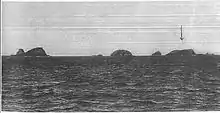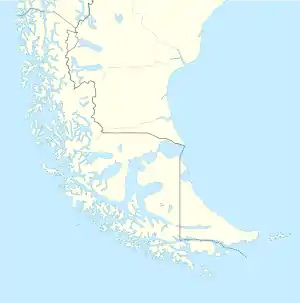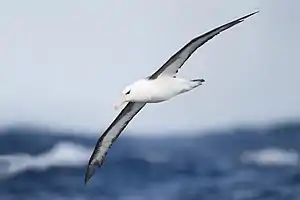Evangelistas Islets
The Evangelistas Islets (Spanish: Islotes Evangelistas) comprise a group of four small, rocky islands lying on the Chilean continental shelf, some 30 km north-west of the western entrance to the Strait of Magellan, in the south-eastern Pacific Ocean, facing the full force of the "Furious Fifties". They come under the jurisdiction of the Chilean Navy which operates the Chilean Maritime Signalling Service and has maintained a presence there since the establishment of the Evangelistas Lighthouse in 1896 by Scottish engineer George Henry Slight.[1][2]
| Native name: Islotes Evangelistas | |
|---|---|
 Photo of the islets by George Henry Slight, the arrow indicating the site of the lighthouse | |
 Evangelistas Islets | |
| Geography | |
| Coordinates | 52.386025°S 75.086615°W |
| Adjacent bodies of water | Pacific ocean |
| Total islands | 4 |
| Administration | |
| Region | Magallanes y la Antártica Chilena |
| Province | Última Esperanza |
| Commune | Puerto Natales |
| Additional information | |
| NGA UFI=-882479 | |
On February 17, 1676, sixteen men of Pascual de Iriate's expedition were lost at Evangelistas Islets while attempting to install a bronze plaque indicating the areas ownership by the King of Spain.[3]
Description
The largest of the group is Evangelistas Grande which is about 400 metres (1,300 ft) long and wide, reaches a height of 60 metres (200 ft) and supports the lighthouse. The other, uninhabited, islets are Elcano 300 by 100 metres (980 ft × 330 ft), Lobos 400 by 150 metres (1,310 ft × 490 ft), and Pan de Azúcar 200 by 200 metres (660 ft × 660 ft). They are mainly bare rock with steep cliffs on their western sides and are exposed to strong winds and rough seas. Lobos and Elcano are home to breeding colonies of black-browed albatrosses with a combined estimate of 4670 pairs recorded in a 13 October 2002 aerial survey.[2] The islets have been recognised as an Important Bird Area (IBA) by BirdLife International for their albatross colonies.[4]

Climate
| Climate data for Evangelistas Islets | |||||||||||||
|---|---|---|---|---|---|---|---|---|---|---|---|---|---|
| Month | Jan | Feb | Mar | Apr | May | Jun | Jul | Aug | Sep | Oct | Nov | Dec | Year |
| Average high °C (°F) | 10.6 (51.1) |
10.6 (51.1) |
10.5 (50.9) |
9.3 (48.7) |
8.1 (46.6) |
6.8 (44.2) |
5.9 (42.6) |
6.0 (42.8) |
6.4 (43.5) |
7.3 (45.1) |
8.3 (46.9) |
9.6 (49.3) |
8.3 (46.9) |
| Daily mean °C (°F) | 8.7 (47.7) |
8.8 (47.8) |
8.3 (46.9) |
7.2 (45.0) |
6.0 (42.8) |
4.8 (40.6) |
4.4 (39.9) |
4.4 (39.9) |
4.9 (40.8) |
5.5 (41.9) |
6.4 (43.5) |
7.6 (45.7) |
6.4 (43.5) |
| Average low °C (°F) | 6.1 (43.0) |
6.6 (43.9) |
5.9 (42.6) |
4.9 (40.8) |
3.7 (38.7) |
2.7 (36.9) |
2.4 (36.3) |
2.4 (36.3) |
2.8 (37.0) |
3.5 (38.3) |
4.1 (39.4) |
5.4 (41.7) |
4.1 (39.4) |
| Average precipitation mm (inches) | 233.4 (9.19) |
225.2 (8.87) |
275.5 (10.85) |
247.7 (9.75) |
215.2 (8.47) |
211.9 (8.34) |
216.4 (8.52) |
214.1 (8.43) |
224.5 (8.84) |
164.7 (6.48) |
170.2 (6.70) |
170.9 (6.73) |
2,569.7 (101.17) |
| Average relative humidity (%) | 83 | 83 | 83 | 83 | 88 | 82 | 82 | 81 | 82 | 83 | 83 | 83 | 83 |
| Source: Bioclimatografia de Chile[5] | |||||||||||||
See also
References
- Rowlett, Russ (2012-09-20). "Evangelistas". Lighthouses of Southern Chile. University of North Carolina. Retrieved 2013-01-06.
- Arata, Javier; Robertson, Graham; Valencia, Jose; Lawton, Kieran (2003). "The Evangelistas Islets, Chile: a new breeding site for Black-browed Albatrosses". Polar Biology. 26 (10): 687–690. doi:10.1007/s00300-003-0536-6.
- de Vea, Antonio (1886). "Expedición de Antonio de Vea". Anuario Hidrográfico de la Marina de Chile (in Spanish). Valparaíso. pp. 5879–590.
- "Islotes Evangelistas". BirdLife Data Zone. BirdLife International. 2021. Retrieved 23 January 2021.
- Hajek, Ernst; Castri, Francesco (1975). "Bioclimatografia de Chile" (PDF) (in Spanish). p. 212. Retrieved 23 April 2015.
External links
- Elsio Hugo Cárcamo Velásquez Faro Evangelista in historianaval.cl
- Islands of Chile @ United Nations Environment Programme
- World island information @ WorldIslandInfo.com
- South America Island High Points above 1000 meters
- United States Hydrographic Office, South America Pilot (1916)